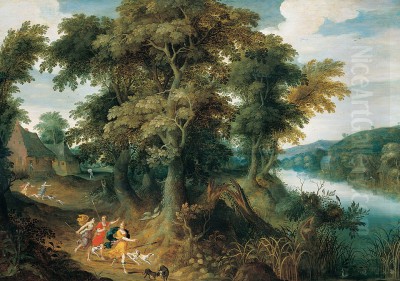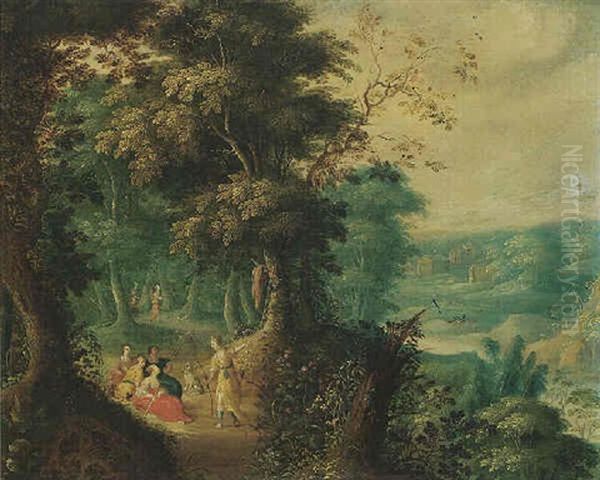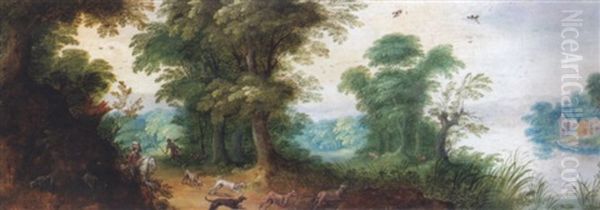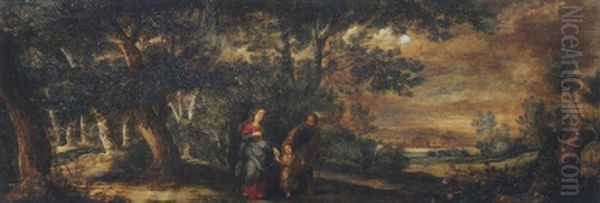Introduction: An Enigmatic Figure in Flemish Art

The early 17th century witnessed a flourishing of artistic production in the Southern Netherlands, particularly in the vibrant hub of Antwerp. Amidst the towering figures of Peter Paul Rubens and Anthony van Dyck, numerous highly skilled specialists carved out their niches. Among these was Jasper van der Laanen, a painter primarily recognized for his evocative depictions of woodland landscapes. Active during a period rich with innovation, Van der Laanen contributed to the popular genre of landscape painting, often infusing his scenes with mythological or biblical narratives.
However, reconstructing the life and oeuvre of Jasper van der Laanen presents certain challenges for art historians. Scholarly sources sometimes offer conflicting information regarding his precise lifespan, with some records suggesting activity between 1592 and 1626, while others point to a Jasper van der Lanen (note the slightly different spelling) living from 1585 to 1634. This ambiguity necessitates careful consideration when attributing works and interpreting biographical details. This exploration will primarily focus on the figure associated with the 1592-1626 timeframe, drawing upon the available evidence while acknowledging these historical uncertainties.
Formative Years and Antwerp Connections
Details regarding Jasper van der Laanen's specific place of birth and death remain elusive in historical records. What is known places him firmly within the artistic milieu of Antwerp, the dominant cultural and economic center of the Spanish Netherlands at the time. His formal training is linked to Nicolaas Geerts, an artist about whom less is known today, but who evidently prepared Van der Laanen sufficiently for a professional career.
A significant milestone in Van der Laanen's life occurred in 1615 when he was registered as a master in the prestigious Antwerp Guild of Saint Luke. Membership in the Guild was essential for any artist wishing to practice independently, take on pupils, or sell their work within the city. It signified that he had completed his apprenticeship and demonstrated the required level of skill to his peers. This membership places him squarely within the established structures of the Antwerp art world during its golden age.
The Allure of the Woodland: Style and Influences

Jasper van der Laanen established himself as a specialist in landscape painting, with a particular affinity for depicting dense, wooded interiors. His works often feature pathways winding through forests, sunlight filtering through thick canopies, and a meticulous attention to foliage. This focus aligns with a broader trend in Flemish art, where landscape evolved from mere background settings into a respected genre in its own right.
The influence of earlier masters can be discerned in his approach. The legacy of Pieter Bruegel the Elder, who revolutionized landscape painting in the previous century by emphasizing naturalism and peasant life, cast a long shadow. While Van der Laanen's style is distinct, the interest in detailed observation of nature and the creation of immersive landscape spaces echoes the innovations of Bruegel and his followers, such as Jan Brueghel the Elder, known for his own highly detailed forest scenes and flower paintings. Van der Laanen's work, often executed on panel and sometimes relatively small in scale, fits comfortably within the tradition of cabinet painting popular among Antwerp collectors.
His landscapes were not merely topographical records but often served as stages for narrative scenes. He integrated figures drawn from mythology, the Bible, or pastoral tradition into his sylvan settings. This combination allowed him to showcase his skill in rendering nature while also appealing to the educated tastes of patrons who appreciated classical and religious themes. The careful balance between landscape and narrative is a hallmark of his attributed works.
A Defining Partnership: Abraham Govaerts
Perhaps the most well-documented aspect of Jasper van der Laanen's professional life is his close association with fellow Antwerp landscape painter Abraham Govaerts (1589-1626). Govaerts was another highly regarded specialist in wooded landscapes, known for his detailed and often brightly lit forest scenes, frequently featuring prominent, carefully rendered trees. The two artists appear to have worked in a similar vein, and their careers significantly overlapped.
Sources indicate a direct collaboration between Van der Laanen and Govaerts. They are mentioned as having worked together, sometimes contributing landscape elements to paintings where figures were added by other specialists, a common practice in Antwerp workshops. For instance, they collaborated on works involving the prolific figure painter Frans Francken the Younger (1581-1642), where Govaerts and Van der Laanen would provide the landscape setting for Francken's narrative scenes.

Furthermore, Govaerts seems to have exerted a noticeable influence on Van der Laanen's style. Govaerts often structured his compositions around one or more large, centrally placed trees, a compositional device that can also be observed in works attributed to Van der Laanen. This suggests a shared artistic vocabulary and potentially a master-pupil or senior-junior colleague relationship, although Van der Laanen was registered as a master independently.
An intriguing detail highlighting their close connection is the report that following Abraham Govaerts' relatively early death in 1626, Jasper van der Laanen was involved in completing some of Govaerts' unfinished paintings. This task would typically fall to a trusted colleague or workshop assistant, underscoring the professional and possibly personal ties between the two artists. This act also suggests Van der Laanen was active up to, and likely beyond, 1626, adding another layer to the discussion around his precise dates.
Signature Works and Narrative Landscapes
While a comprehensive catalogue raisonné might be complicated by attribution issues, several works provide insight into Van der Laanen's artistic output. One painting frequently associated with him is a wooded landscape sometimes referred to as "Spacer door de bossen" (literally "Walker through the woods," likely signifying a generic title like "Wooded Landscape with Figure"). Historical records mention such a work being auctioned in 1896 and later, in 1953, acquired by the Museum Boijmans Van Beuningen (formerly referred to as Museum van Stedelijk) in Rotterdam.
Interestingly, this specific painting, or one very similar, has also been subject to attribution debates, having at times been linked to Abraham Govaerts or an obscure artist named S. Niedelski. Such confusion is not uncommon for artists working in similar styles within the same period and location. However, its association with Van der Laanen persists in several sources, highlighting his reputation for this type of intimate forest scene.
Another significant work attributed to Van der Laanen is the "Landscape with Pyramus and Thisbe," dated around 1615. This painting depicts the tragic lovers from Ovid's Metamorphoses, a popular theme in Baroque art. Van der Laanen sets the dramatic climax of the story within a typically lush, detailed forest clearing. The choice of subject demonstrates his engagement with classical literature and his ability to integrate narrative figures convincingly into his landscape settings. This theme was tackled by many artists, including later masters like Nicolas Poussin, whose 1651 version is renowned, and the Pre-Raphaelite John William Waterhouse centuries later, indicating the enduring appeal of the story.

Van der Laanen is also credited with painting mythological scenes such as "Diana and her Nymphs." This subject, featuring the Roman goddess of the hunt and her attendants, provided ample opportunity to combine idealized female figures with a richly rendered woodland environment, playing to his strengths as a landscape specialist. Such works catered to the demand for decorative paintings with classical allusions.
Antwerp's Golden Age: The Artistic Milieu
To fully appreciate Jasper van der Laanen's career, it is essential to consider the vibrant artistic environment of early 17th-century Antwerp. Despite political and economic challenges following the Dutch Revolt, the city remained a powerhouse of artistic production, driven by church commissions, aristocratic patronage, and a burgeoning open market for art. Van der Laanen worked alongside some of the most influential figures in European art history.
Peter Paul Rubens dominated the scene with his dynamic Baroque style, large workshop, and international fame. His influence was pervasive, although specialists like Van der Laanen maintained their distinct focus. Anthony van Dyck, initially Rubens's assistant, achieved renown for his elegant portraiture. Jacob Jordaens was another major figure, known for his robust genre scenes and historical paintings.
Within landscape painting itself, Antwerp offered a rich tradition. Besides the Bruegel dynasty (Pieter the Elder, Jan the Elder, Jan the Younger) and Van der Laanen's collaborator Abraham Govaerts, artists like Joos de Momper were creating dramatic mountain views and panoramic vistas. The city's Guild of Saint Luke fostered a community where artists often collaborated, sharing expertise in figures, landscapes, animals, or still life elements to produce complex works efficiently. This collaborative spirit is evident in Van der Laanen's own work with Govaerts and Francken.
The market demanded various types of paintings, from large altarpieces to smaller cabinet pictures intended for domestic interiors. Van der Laanen's detailed woodland scenes fit well into the latter category, appealing to collectors who appreciated fine execution and pleasing subject matter. His specialization allowed him to thrive within this competitive but supportive ecosystem.
Navigating Historical Ambiguities
Despite his documented activity and Guild membership, Jasper van der Laanen remains a somewhat shadowy figure compared to his most famous contemporaries. The lack of detailed biographical records – specific birth and death dates and locations, information about his family, or extensive documentation of commissions – makes a complete reconstruction of his life difficult.

The confusion surrounding his name (van der Laanen vs. van der Lanen) and lifespan (1592-1626 vs. 1585-1634) is a significant hurdle. It is possible that there were two distinct artists with very similar names active around the same time, or that records are simply inconsistent regarding a single individual. The Jasper van der Lanen (1585-1634) mentioned in some sources might be the same person, with the dates representing a fuller lifespan, or a different artist altogether. Without definitive evidence, scholars must often rely on stylistic analysis and the context of documented collaborations, like that with Govaerts (who died in 1626), to anchor attributions and biographical sketches.
Furthermore, the collaborative nature of Antwerp workshops and the similarity in style among landscape specialists of the era contribute to attribution challenges. Works could easily be misattributed over time, especially if unsigned. The case of "Spacer door de bossen," potentially linked to Van der Laanen, Govaerts, and Niedelski, exemplifies this issue. These ambiguities remind us that art history is an ongoing process of research and interpretation, particularly for artists operating just below the level of international stardom.
Enduring Traces: Legacy and Conclusion
Jasper van der Laanen occupies a specific place within the grand narrative of Flemish Baroque art. He was a skilled practitioner of landscape painting during a period when the genre reached new heights of popularity and sophistication in Antwerp. His specialization in detailed, often intimate, woodland scenes contributed to the diversity of artistic production in the city.
His most clearly defined legacy might be his close association and collaboration with Abraham Govaerts. Their shared stylistic concerns and documented partnership illuminate the workings of the Antwerp art world, where specialization and cooperation were common strategies for success. The fact that Van der Laanen was entrusted with completing Govaerts' works speaks to his reputation and skill among his peers.
While perhaps not an innovator on the scale of Rubens or the Brueghels, Van der Laanen competently practiced his craft, creating appealing works that found favour with contemporary collectors. His paintings, such as the "Landscape with Pyramus and Thisbe" and the various wooded scenes attributed to him, showcase a sensitivity to the nuances of the natural world combined with an ability to integrate narrative elements effectively.
In conclusion, Jasper van der Laanen remains a figure worthy of study, representing the many talented specialists who formed the bedrock of Antwerp's artistic supremacy in the early 17th century. His work provides valuable insight into the development of Flemish landscape painting and the collaborative practices of the time. Though shrouded in some historical ambiguity, his forested paths continue to invite exploration, offering glimpses into the sylvan beauty captured by a dedicated Flemish master.